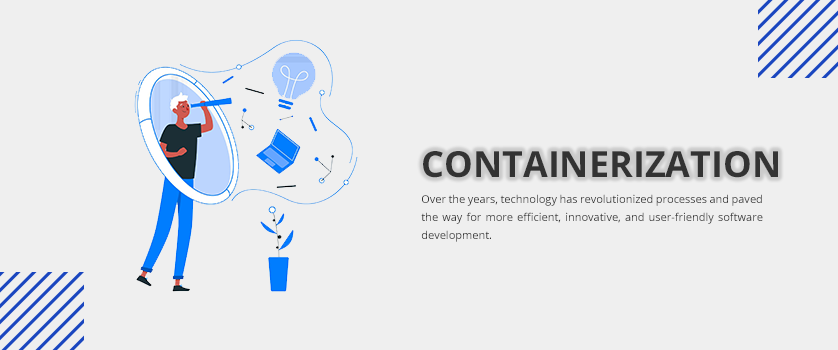


Over the years, technology has revolutionized processes and paved the way for more efficient, innovative, and user-friendly software development. However, this has created intense pressure on the IT industry to deliver quality products with new features and functionality at a faster and agile pace. To combat this challenge, software enterprises worldwide have incorporated DevOps into their software development life cycle (SDLC) to ensure continuous software development, deployment, and delivery, all without compromising the software quality and performance.
Moreover, to further achieve this goal successfully, enterprises are readily adopting Containerization, a prominent DevOps practice that allows developers to create and deploy applications faster and more securely.
But!What is Containerization? What makes it so efficient? Why is it so popular among software developers today?
If you want to get the answers to these questions and more, continue reading the following article, where we explore the concepts of Containerization technology to understand its significance in software development.
Let’s Get Started!An alternative or companion to virtualization, Containerization is a form of operating system virtualization used to run applications in an isolated user-space called containers, using the same shared operating system (OS). It is a new approach to application provisioning that involves encapsulating or packaging up software code and all its dependencies for uniform and consistent execution on any infrastructure. It is among the most beneficial development methodologies that enable developers to build and deploy applications faster and securely.
Containerization eliminates bugs and errors that result from the transfer of code from a specific computing environment to a new location by bundling the application code together with the related configuration files, libraries, and dependencies that are required for the application to run.
This single package of software, known as a container, is abstracted away from the host operating system, which allows it to run across multiple platforms or Cloud without any issues or errors. These containers offer immense flexibility as they are quick and easy to deploy and manage and require fewer resources to run.
In short, Containerization is a consistent, portable, secure, and efficient virtualization solution that drastically increases the agility of CI/CD cycles, reduces heavyweight legacy applications into lightweight parts, and helps minimize resource usage and system outages. It is one of the latest developments in Cloud Computing that allows enterprises to modernize their existing applications, create new Cloud-native enterprise applications, and work with Cloud services effectively.
One of the major trends in software development today, Containers are a standardized unit of software abstracted from the operating system that helps organizations, both large and small, streamline application build, test, deployment, and redeployment on various environments. Using containers for development is an efficient way of improving application life-cycle management, with capabilities like continuous integration and delivery.
Containers, the lightweight software components, package up everything required to execute an app, such as the code and all its dependencies, and allow developers to create an application on a local environment and deploy it to an on-premises data center or even the cloud servers, which ensures quick and reliable execution.
There are two major types of Containers, based on the different problems they are oriented to solve, which are:
To make software development standard, lightweight, and secure, containerization virtualizes the host operating system, specifically Linux Kernel, which also supports multiple containers concurrently. The kernel acts as a bridge between the software of the OS and the hardware of the underlying system.
During this process, each application container assumes it is the only running application, with a set of supporting libraries. This ensures the effectiveness of the application, as all containers run minimal, resources isolated processes that cannot be accessed by others. Since these containers are lightweight (as they share the OS kernel, start faster, and require less memory) they ensure the applications work uniformly despite differences, for instance, between development and staging.
This process involves three important components:
To unlock the power of containerization, organizations need to adopt the best practices that ensure quality, security, and accurate execution of the process. Therefore, here is a list of some critical practices for Containerization:
Two widely used hosting and software development technologies Containerization and Virtualization are often confused with one another, as both (Containers and Virtual Machines) allow multiple types of software to be run in contained environments. Though the two are not mutually exclusive, as Containerization came into being to overcome a variety of Virtualization issues, these can help organizations become more agile, scalable, and responsive to business demands.
Hence, we must familiarize ourselves with these two distinct technologies to better understand their dependency, business requirements, benefits, and more.
|
Containerization
|
Virtualization
|
Containerization, though not new to the field, is making a bigger impact in IT than ever before. The majority of developers today are eagerly embracing the technology over virtual machines to leverage its capabilities to build and distribute application code and dependencies with accuracy, agility, and speed as well as to enjoy the benefits of modern Cloud Computing, DevOps, and Docker. It is a technology that not only offers significant benefits to developers and development teams but also the organization and the end-users.
Therefore, here are some prominent Containerization benefits that make it a popular choice among software engineering teams:
While defining containerization, we cannot overlook its drawbacks. Therefore, here are some disadvantages of containerization that prevent its smooth implementation within an organization.
A revolutionizing trend in the field of software development and management, Containerization is being rapidly embraced by software organizations worldwide, along with Microservices, Cloud Computing, and more. Moreover, the technology is being backed and supported by tech giants like IBM and Google, which further guarantees that its popularity and adoption will continue to increase in both magnitude and speed in the coming years.
Containerization, with its portability, agility, fault isolation, ease of management, and security is a superior software development approach that allows teams to move fast, deploy software efficiently, and operate at an unprecedented scale.